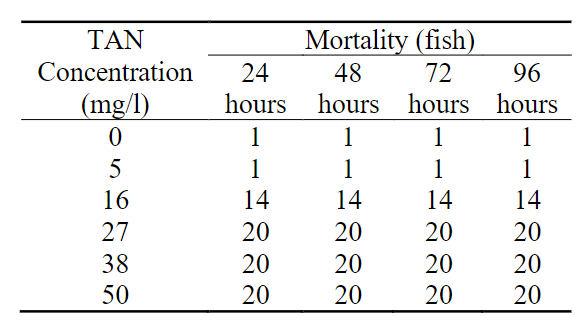Ammonia Toxicity to Rinuak (Gobiopterus brachypterus) of Lake Maninjau
DOI:
https://doi.org/10.51264/inajl.v1i1.6Keywords:
Acute toxicity, Ammonia, LC50, Gobiopterus brachypterusAbstract
Rinuak (Gobiopterus brachypterus) has an important economic value for local communities in Lake Maninjau - West Sumatra. The catch of G. brachypterus is decreasing along with the decline of the water quality. Ammonia is considered one of the most toxic pollutants in the aquatic ecosystem. It can be produced from the natural decomposition of organic matter or excreted by aquatic organisms as a nitrogenous waste product. Therefore, the information about toxicity ammonia in G. brachypterus is important as a management tool for fish conservation in Lake Maninjau. This research was aimed to find the LC50 value of ammonia in G. brachypterus. A static acute toxicity test was conducted for 96 hours. The fish were exposed to different test chemical concentration level for 96 hours, under static conditions. Mortality was recorded and concentration killed 50% of the fish was determined as LC50-96h, No Observed Effect Concentration (NOEC), and Lowest Observed Effect Concentration (LOEC). Values of LC50-96h, No Observed Effect Concentration (NOEC) and Lowest Observed Effect Concentration (LOEC) were 11.62 mg/L TAN or 0.27 mg/L NH3, 5 mg/L TAN or 0.12 mg/L NH3 and 16 mg/L TAN or 0,37 mg/L NH3, respectively. Ammonia’s Maximum Acceptable Tolerant Concentration (MATC) for G. brachypterus was 8.9 mg/L TAN or 0.21 mg/L NH3. The acute toxicity result showed that Rinuak (G. brachypterus) was sensitive to ammonia. The information about ammonia toxicity data is important for the determination of water quality guidelines in Lake Maninjau.
References
Alabaster JS & Lloyd R. 1982. Water Quality Criteria for Freshwater Fish. Food and Agricultural Organization of the United Nation, London, Boston.
Arillo A, Margiocco C, Melodia F, Mensi P, and Schenone G. 1981. Ammonia toxicity mechanism in fish: Studies on rainbow trout (Salmo gairdneri Richardson.). Ecotoxicology and environmental safety, 5(3), 316-328. DOI: 10.1016/0147-6513(81)90006-3.
Azis CH. 2016. Ecotechnology and ecosystembased management tools as alternative solutions to reduce risks of ecosystem disaster and fish kill in Lake Maninjau. Proc. Nat. Sem. Limnology.
Bhakta JN. 2006. Ammonia Toxicity to Four Freshwater Fish Species: Catlacatla, Labeobata, Cyprinus carpio, and Oreochromis mossambica. Electronic Journal of Biology, 2(3), 39 -41.
Carmago J & Alonso A. 2006. Ecological and toxicological effects of inorganic nitrogen pollution in aquatic ecosystems: A global assessment. Environment international, 32, 831-849.
Eddy FB. 2005. Ammonia in estuaries and effects on fish. Journal of Fish Biology, 67, 1495-1513. DOI: 10.1111/j.1095-8649.2005.00930.x
Imam M. 2011. Variasi Morfologi pada Ikan Lempuk (Gobiopterus brachypterus) di Danau Ranu Grati Pasuruan. Magister Thesis ed. Universitas Brawijaya. http://repository.ub.ac.id/157878/
Kottelat M, Kartikasari SN, Whitten T, and Wirjoatmodjo S. 1993. Freshwater Fishes of Western Indonesia and Sulawesi. Periplus Editions, Singapore.
Kwik JTB & Yeo DCJ. 2015. Differences in ?sh assemblages in protected and non-protected freshwater streams in a tropical urbanized country. Hydrobiologia, 762, 143-156. DOI: 10.1007/s10750-015-2344-8
Larson HK, Jaafar Z, and Lim KKP. 2008. An Annotated Checklist of The Gobioid Fishes of Singapore. The Raffles Bulletin of Zoology, 56(1), 135-155.
Mardones A, González M, Rivas-Mancilla C, Vega R, Augsburger A, Encina F, and De los Ríos P. 2019. Determination of acute toxicity of ammonium in juvenile Patagonian blenny (Eleginopsmaclovinus). Brazilian journal of biology, 79(4), 646-650. DOI: 10.1590/1519-6984.186991
Ott G. 2011. First records of Gobiopterus brachypterus and Mugilogobius tigrinus from Sri Lanka (Teleostei, Perciformes, Gobiidae: Gobionellinae). Bulletin of Fish Biology, 13(1), 71-75.
Rand GM. 1995. Fundamentals of Aquatic Toxicology (2nd ed.). CRC Press, Boca Raton. DOI: 10.1201/9781003075363
Randall DJ & Tsui TK. 2002. Ammonia toxicity in fish. Marine Pollution Bulletin, 45, 17-23.
Rao KS. 2018. Special Commentary on Maximum Acceptable Toxicant Concentration (MATC). BEMS reports, 4(2), 37 - 38.
Roesma DI, Tjong DH, and Aidil DR. 2020. Phylogenetic analysis of transparent gobies in three Sumatran lakes, inferred from mitochondrial Cytochrome Oxidase I (COI) gene. Biodiversitas, 21(1), 43-48. DOI: 10.13057/biodiv/d210107
Russo RC. 1985. Ammonia, nitrite, and nitrate. In G. M. Rand & S. R. Petrocelli (Eds.), Fundamentals of aquatic toxicology and chemistry. Hemisphere Publishing Corp., Washington D.C., 455-471.
Tanjung LR. 2015. Kondisi Terkini Kualitas Air dan Tingkat Kesuburan Danau Maninjau. LEMBAGA ILMU PENGETAHUAN INDONESIA. Retrieved Desember 7, 2020. from http://lipi.go.id/publikasi/kondisi-terkini-kualitas-air-dan-tingkat-kesuburan-danau-maninjau/23101
Thurston RB & Russo R. 1983. Acute Toxicity of Ammonia to Rainbow Trout. Transactions of the American Fisheries Society, 112(5), 696-704. DOI: 10.1577/1548-8659(1983)112<696:ATOA TR>2.0.CO;2
Tomasso JR, Goudie CA, Simco BA, and Davis KB. 1980. Effects of environmental pH and calcium on ammonia toxicity in channel catfish. Transactions of the American Fisheries Society, 109(2), 229-234. DOI: 10.1577/1548-8659(1980) 109<229:EOEPAC>2.0.CO;2
USEPA. 1998. Guidelines for risk assessment. U.S. Environmental Protection Agency, Washington, DC.
USEPA. 2002. Methods for Measuring the Acute Toxicity of Effluents and Receiving Waters to Freshwater and Marine Organisms (5th ed.). U.S. Environmental Protection Agency Office of Water, (4303T)1200 Pennsylvania Avenue, NW; Washington, DC 20460. EPA-821-R-02-012?
USEPA. 2013. Aquatic Life Ambient Water Quality Criteria for Ammonia – Freshwater. U.S. Environmental Protection Agency Office of Water Office of Science and Technology; Washington, DC.
Yoga GP & Nursodiyanti S. 2018. Toksisitas Amonia terhadap benih Ikan Sidat (Anguilla bicolor). Prosiding Seminar Nasional Ikan, 10, 335 - 343.
Yoga GP & Samir O. 2020. Ammonia toxicity to endemic fish (Rasbora maninjau) of Lake Maninjau as a reference for water quality guidelines. IOP Conference Series: Earth and Environmental Science, 525, 1-7. DOI: 10.1088/1755-1315/535/1/012009
Yosmeri. 2013. Status perkembangan usaha budidaya ikan dengan karamba jaring apung di Danau Maninjau, Sumatera Barat” (State of cage aquaculture business development in Lake Maninjau, West Sumatera). Workshop on Environmental Management of cage aquaculture in open waters (3 – 4 October 2013 ed.). Directorate General of Aquaculture, Ministry of Marine and Fisheries.







